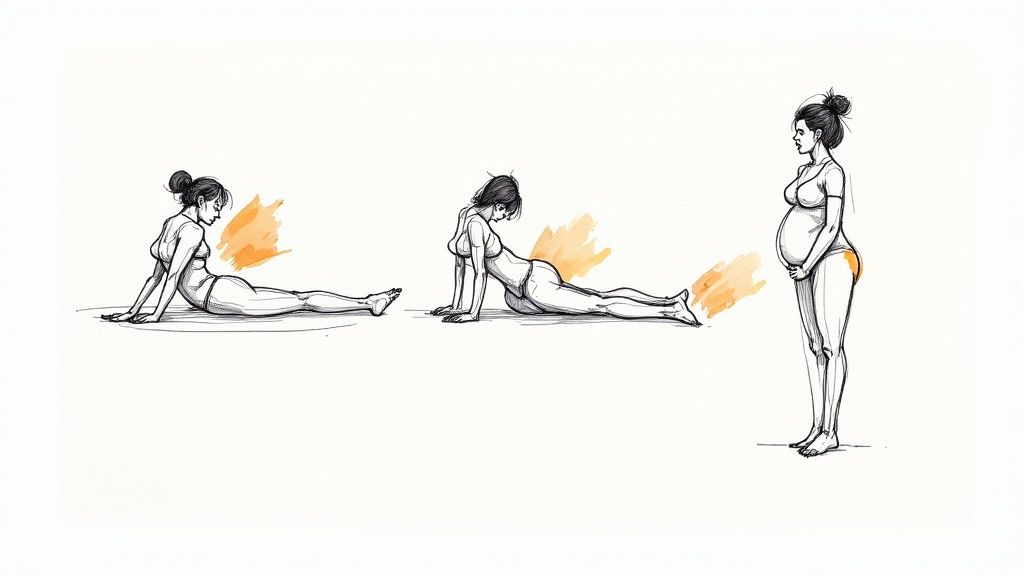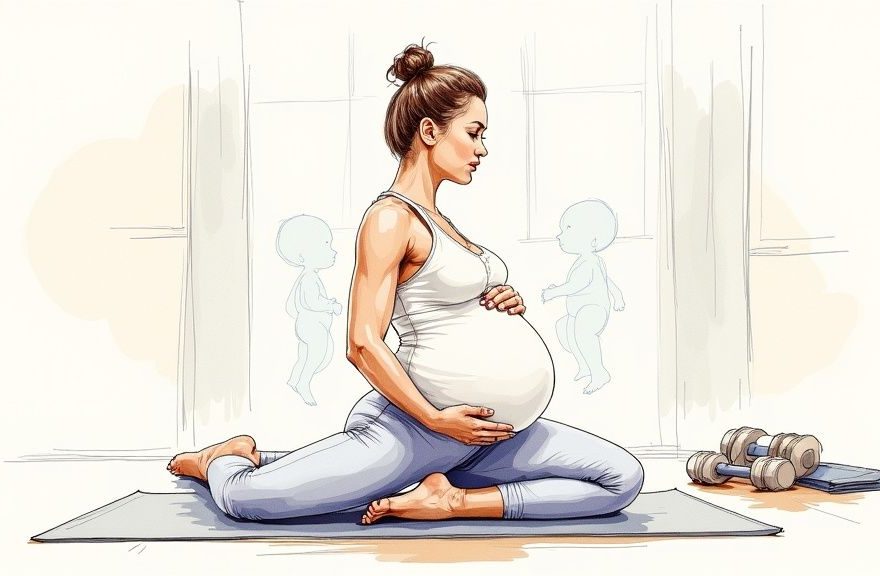Understanding Why Movement Matters During Pregnancy

Regular exercise during pregnancy does much more than help you stay in shape – it creates a foundation for a healthier pregnancy journey for both you and your baby. The benefits are clear and scientifically proven: women who maintain an active pregnancy have lower risks of complications like gestational diabetes and preeclampsia. By moving a regular part of your routine, you’re actively supporting your baby’s development while taking care of your well-being.
The Science Behind the Benefits
Research shows just how powerful pregnancy exercise can be. Studies have found that doing 150 minutes of moderate exercise each week can reduce pregnancy complications by up to 40%. This activity leads to better birth outcomes overall, with fewer cases of preterm births and C-sections. Beyond these major benefits, regular movement helps manage common pregnancy discomforts – from easing back pain to boosting energy levels and improving mood. The evidence makes it clear that staying active during pregnancy pays off in multiple ways.
Real-World Impact of Safe Pregnancy Workouts
Many women who maintain safe exercise routines during pregnancy report significant improvements in their daily lives. They often sleep better, have more energy throughout the day, and generally feel more positive during their pregnancy journey. The benefits continue after delivery too – women who stay active while pregnant often find it easier to recover postpartum. Their maintained strength and fitness provide a solid foundation for handling the physical demands of caring for a newborn.
Tailoring Your Approach to Safe Pregnancy Workouts
When it comes to pregnancy exercise, there’s no one-size-fits-all approach. Your workout routine should reflect your situation – including your pre-pregnancy fitness level, current health status, and your doctor’s recommendations. For example, if you regularly exercised before pregnancy, you may be able to continue many of your usual activities with some modifications. However, if you’re new to exercise, you’ll want to start gradually with gentler options.
Starting Safely and Effectively
If you haven’t exercised recently, begin with simple, low-impact activities like daily walks or swimming. As you build strength and stamina, you can slowly increase how long and intensely you work out, while always staying mindful of how your body feels. This measured approach helps prevent injury and creates lasting habits that benefit you throughout your pregnancy. Having a clear understanding of why movement matters during pregnancy empowers you to make informed choices about staying active – choices that support both your health and your baby’s development.
Navigating Your Fitness Journey Through Each Trimester

Like the distinct chapters of your pregnancy story, your workout routine needs thoughtful adjustments as your body changes. By understanding what happens in each trimester, you can make smart choices about exercise that keep both you and your baby safe. Let’s explore how to adapt your fitness routine throughout your pregnancy journey.
First Trimester: Embracing Gentle Movement
Those early weeks often bring waves of tiredness and morning sickness that can make exercise feel challenging. Start small with gentle activities that energize without overwhelming. A simple 20-minute walk a few times each week can help boost your mood and ease nausea. Swimming and prenatal yoga are also excellent choices – they’re easy on your body while helping you stay active. Think of these early workouts as building your foundation for the months ahead.
Second Trimester: Finding Your Fitness Groove
Many women find their energy returns during these middle months, often called the “sweet spot” of pregnancy. This is your time to try different types of safe exercise as you feel stronger. You might add light weights or resistance bands to build strength for carrying your growing baby. Squats and modified push-ups work well, but skip exercises that have you lying flat on your back since this can affect blood flow. The good habits you build now will help carry you through the rest of your pregnancy.
Third Trimester: Prioritizing Comfort and Stability
As your baby grows bigger, your shifting center of gravity affects your balance more each day. While you don’t need to stop moving, you’ll want to adjust your routine for comfort and safety. If running was your go-to activity, try walking or using an elliptical instead. Water exercises and prenatal yoga can ease back pain and swelling while keeping you active. Even short 15-minute movement breaks bring benefits. Think of these adjustments as finding new ways to stay active that work for your changing body.
| Trimester | Focus | Example Workouts | Key Considerations |
|---|---|---|---|
| First | Gentle Movement | Walking, swimming, prenatal yoga | Manage fatigue and nausea |
| Second | Increased Activity | Brisk walking, light strength training, cycling | Avoid exercises lying flat on your back |
| Third | Comfort and Stability | Modified exercises, water aerobics, prenatal yoga | Adapt to shifting balance and growing belly |
The key to staying active during pregnancy is being flexible and listening to your body’s needs. Each trimester brings different changes, so adjust your workouts accordingly. Always check with your doctor before starting new exercises during pregnancy, and pay attention to how your body responds. Small, consistent efforts to stay active can make a big difference in how you feel throughout these nine months.
Building Your Pregnancy-Safe Exercise Toolkit

As your pregnancy progresses, adjusting your fitness routine becomes essential for both you and your baby’s wellbeing. The right mix of exercises can help maintain muscle tone, improve posture, and prepare your body for the journey ahead. Let’s explore specific workouts that are both safe and beneficial during pregnancy.
Exploring Low-Impact Cardio Options
Getting your heart rate up safely is key during pregnancy. The good news is there are several gentle yet effective cardio options that won’t strain your joints. Walking is perhaps the simplest way to stay active – just 30 minutes of brisk walking can boost your energy and mood. Swimming is another excellent choice, as the water supports your weight and helps prevent overheating. Many moms-to-be also enjoy using a stationary bike, which lets you control your pace and resistance. The goal is to find activities that get your blood flowing while still feeling comfortable.
Strength Training for a Supportive Core
Your core muscles need extra attention during pregnancy but in a careful way. Skip traditional ab exercises like crunches and sit-ups, which can worsen muscle separation (diastasis recti). Instead, try gentler moves that target your deep core muscles. Wall planks, where you lean against a wall at an angle, are a great option. The bird-dog exercise, done on hands and knees, helps with balance and stability. Light weights or resistance bands can strengthen your arms and legs – just keep the weight modest and focus on proper form. These exercises help prepare your body for carrying and caring for your baby.
The Power of Flexibility and Balance
As your center of gravity shifts, staying flexible and balanced becomes more important each week. Prenatal yoga classes offer a perfect blend of gentle stretching, strengthening, and relaxation techniques. Many women find the breathing practices especially helpful for managing stress and preparing for labor. Simple balance exercises, like standing on one foot while holding onto a chair, help you adjust to your changing body. Just take extra care as your belly grows, and always have support nearby if needed.
Recognizing Your Body’s Signals
Learning to read your body’s cues is crucial for safe pregnancy exercise. A good rule of thumb: you should be able to carry on a conversation while working out. If you feel dizzy, short of breath, or experience any pain, take a break. Stay extra mindful of hydration – keep water nearby and drink often. Wear loose, comfortable clothes and choose cooler times of the day for outdoor activities. Remember that modifying your workout isn’t a step backward – it’s smart self-care that benefits both you and your baby. By staying aware and making adjustments when needed, you can maintain an active, healthy pregnancy.
Mastering Essential Safety Protocols and Warning Signs

A safe pregnancy workout routine goes beyond just picking suitable exercises – it requires you to understand and respond to your body’s signals while following key safety guidelines. When you know what to watch for and how to react, you can exercise confidently while keeping yourself and your baby protected.
Listening to Your Body’s Wisdom
Your body sends important signals during pregnancy workouts that help guide safe exercise. A simple way to check if you’re working too hard is the “talk test” – you should be able to carry on a conversation while moving. If you find yourself getting too breathless to chat easily, that’s your cue to dial back the intensity or take a break. While some muscle soreness is expected after exercise, any sharp or ongoing pain means you should stop and check with your doctor or prenatal fitness instructor. Being proactive about monitoring these signals helps prevent problems before they start.
Essential Safety Guidelines for Safe Pregnancy Workouts
Staying well-hydrated is especially important when exercising during pregnancy. Make sure to drink water before, during, and after workouts to help regulate your body temperature. Wearing loose, comfortable clothes that breathe well makes moving easier. Try to schedule outdoor workouts for cooler times of day, or exercise indoors when it’s hot out. These basic but important steps create better conditions for safe pregnancy exercise.
Recognizing Warning Signs During Exercise
While some discomfort during exercise is normal, certain symptoms need immediate attention. Stop exercising and contact your doctor if you experience vaginal bleeding, dizziness, chest pain, or swelling/pain in your calves. Also watch for concerning changes like decreased fetal movement or regular, painful contractions. Quick action when these warning signs appear helps protect both you and your baby’s health.
Maintaining Proper Form Throughout Your Pregnancy
Your changing body affects your balance and posture during pregnancy workouts. As your belly grows, your center of gravity shifts, making you more likely to lose balance. Focus on engaging your core muscles to stay stable – think about gently hugging your baby rather than letting your abs push outward. This helps prevent abdominal separation (diastasis recti). Watch your posture and avoid overarching your back, which can strain those muscles. Following these form guidelines, along with listening to your body’s signals, helps you exercise safely through each stage of pregnancy.
Separating Fact From Fiction in Prenatal Fitness
Exercise during pregnancy can feel like navigating through a maze of conflicting advice. While regular movement offers clear benefits for both mom and baby, persistent myths often hold expectant mothers back from staying active. The good news? Many common concerns about pregnancy exercise turn out to be unfounded. Take the belief that women shouldn’t start exercising during pregnancy if they weren’t active before – research shows that beginning a gentle exercise program while pregnant, with proper medical guidance, can bring significant health benefits.
Debunking Common Myths About Pregnancy Exercise
“Will exercise harm my baby?” This is perhaps the most frequent worry I hear from expectant mothers. The science tells a different story – studies consistently show that moderate exercise poses minimal risk when done properly. Staying active during pregnancy helps prevent complications like gestational diabetes and preeclampsia. Regular movement can also ease back pain, boost your mood, and give you more energy for daily activities. The key is working with your healthcare provider to find safe activities that match your fitness level and stage of pregnancy.
Safe Exercise for Athletic and First-Time Exercisers
If you were hitting the gym regularly before pregnancy, you may wonder if you need to dramatically scale back. While some adjustments are needed, many fit moms can safely maintain their workout routines with proper modifications. And if you’re new to exercise? Starting slowly with pregnancy-safe activities can still provide major benefits. The trick is gradually building up your endurance while paying close attention to how your body responds. This measured approach helps ensure both safety and effectiveness.
The Importance of Moderate Activity and Healthcare Guidance
The U.S. Department of Health and Human Services recommends pregnant women aim for 150 minutes of moderate exercise each week. This could mean taking brisk walks, doing laps in the pool, or joining prenatal yoga classes. A good rule of thumb: you should be able to carry on a conversation while moving. But remember – every pregnancy journey is unique. Check with your doctor or a qualified prenatal fitness expert before starting any exercise program. They can help create a safe plan tailored to your specific needs and guide you in modifying movements as your body changes.
Real-World Success Stories and Evidence-Based Benefits
Many moms find that staying active during pregnancy improves their sleep quality, energy levels, and overall wellbeing. These personal experiences align with research showing multiple health benefits of prenatal exercise, from easier labor to faster postpartum recovery. By sorting fact from fiction about pregnancy workouts, expectant mothers can feel confident embracing regular movement as part of a healthy pregnancy. Making informed choices about staying active empowers women to support their health while giving their babies the best possible start.
Creating Your Customized Pregnancy Fitness Plan
Exercise during pregnancy can significantly improve your health, wellbeing, and birth experience. However, finding the right approach requires careful consideration of your unique needs and circumstances. Just as every pregnancy journey is different, your fitness routine should match your fitness level, energy, and health status throughout each trimester.
Assessing Your Baseline and Setting Realistic Goals
Start by taking an honest look at your pre-pregnancy fitness level and habits. Were you consistently active before pregnancy, occasionally exercising, or mostly sedentary? Your answer shapes where you begin. For instance, if you regularly practiced Pilates before pregnancy, you might continue with modified movements under your instructor’s guidance. If you’re new to exercise, begin with gentle activities like walking or swimming. Small, consistent efforts make a real difference – even 10-15 minutes of movement benefits both you and your baby.
Designing Your Workout Schedule and Choosing Activities
Consider how exercise can fit naturally into your daily routine. Some women prefer structured 30-minute sessions, while others do better with several shorter bursts of activity throughout the day. Focus on activities you genuinely enjoy, whether that’s prenatal yoga, water aerobics, or dance. The key is finding movement that energizes rather than depletes you. Simple lifestyle adjustments count too – taking a walk during your lunch break or doing gentle stretches while watching TV adds up toward the recommended 150 minutes of weekly moderate activity.
Tracking Progress and Staying Motivated
Keeping a simple record of your activities helps maintain momentum and perspective. Whether you use a basic notebook or a fitness app, note how you feel before and after exercise, not just what you do. Notice improvements in your energy, mood, and strength over time. Remember those first weeks when a few minutes of gentle movement felt challenging? Seeing your progress builds confidence. Joining prenatal exercise classes or finding a walking buddy adds social support and accountability when motivation dips.
Consulting Your Healthcare Team and Adapting Your Plan
Your healthcare provider should guide and approve your fitness choices based on your medical history and pregnancy progression. Regular check-ins allow you to adjust your routine as your body changes and address any concerns promptly. Listen to your body’s signals and modify activities accordingly – some days you’ll feel energetic, others you’ll need more rest. This flexible, mindful approach helps you stay active safely throughout your pregnancy journey.
Ready to start moving safely during pregnancy? Pregnancy 101 offers expert-led live sessions on prenatal and postnatal care, Garbh Sanskar, and more. With flexible scheduling and experienced instructors, you can access personalized guidance from the comfort of your home. Join our community of over 5000 happy moms and discover the benefits of supported pregnancy wellness.

